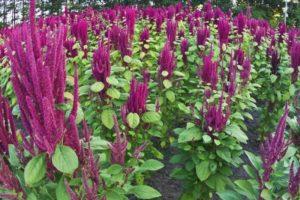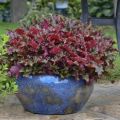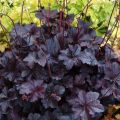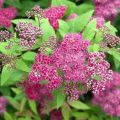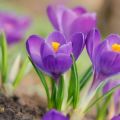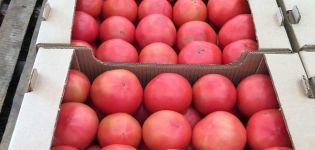Characteristics and descriptions of Heuchera varieties, planting and care rules
Geichera is a herbaceous perennial plant of the Saxifrage family. It has very good decorative qualities, therefore it is an obligatory participant in garden compositions. The main advantage of this plant is its rich foliage. All varieties of decorative heuchera delight with a long flowering period and picturesque foliage of various shapes, shades, textures.
Features:
The homeland of Heuchera is the forests and mountains of North America. For the first time the plant was described by the German botanist Johann Heinrich von Heicher, who lived in the 17th-18th centuries. Modern breeders have developed many ornamental varieties that have spread throughout the world and are successfully used to decorate gardens and parks.
The color and shape of heuchera leaves are amazing and varied. They are dark, yellow, amber, purple, green. May contain streaks, various patterns and blotches. Red-leaved varieties are often found. The foliage surface is smooth, velvety or corrugated.
Heuchera's floral outfit is no less beautiful. The flowering season is long. The plant throws out small bells, collected in paniculate inflorescences.
On decorative grounds, two large groups of plants are distinguished:
- decorative florals are distinguished by the special beauty of flowering;
- ornamental deciduous trees boast a wide variety of deciduous shades.
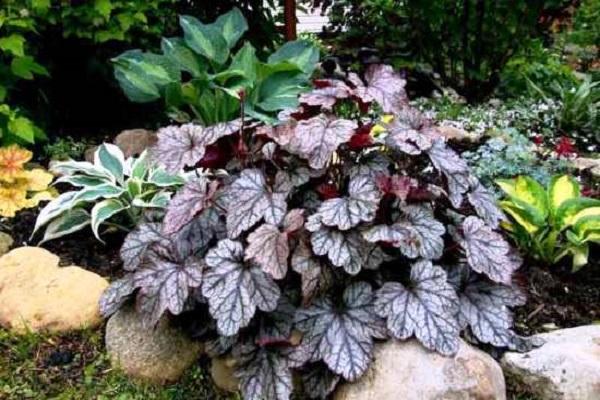
Main types
Experts know more than 70 varieties of Heuchera. Some of them belong to mountain species, the rest of the plants are derived from the forest varieties of wild heuchera. The most popular are several types with the best decorative qualities:
- Heuchera red has several varieties, including blood red, carmine red, and Purple Palace.
- Blood red. Its flowers resemble bright red bells. The variety is cold-resistant, therefore it is actively bred in Russia. It has round, serrated leaves of dense texture.
- Hybrid. It is a hybrid of blood-red and American Heuchera. She combined their best qualities. Has large inflorescences of white pink or coral shades.
- Purple Palace. A variety of red heuchera, it has beautiful leaves of deep red hues. It is very unpretentious, therefore it is often used by landscape design specialists.
- Small-flowered. Possesses the best decorative properties.It has beautiful carved leaves, painted in silver or purple. Small pink flowers are combined into inflorescences in the form of elongated panicles.
- Geichera Starburst (Old Castle) is actively planted due to its rich color palette. Differs in unpretentiousness, pleases the eye during the whole warm period. Combines well with dwarf shrubs to create garden compositions.
- Green. Has foliage in all shades of green. The Sasha variety is very popular, with olive-colored lace leaves.
- Hairy. Large leaves and peduncles have a velvety surface.
- Geichera Rio. Has elegant cream and yellow leaves. The plant blooms in mid-summer. It is an original decoration of a flower bed, therefore it is often used by gardeners and landscaping masters.
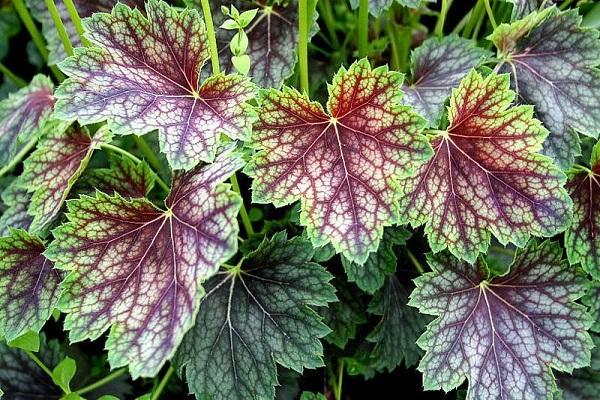
The specifics of growing crops
There are two ways to plant a Heuchera on your site: by growing a seedling from seeds or by purchasing it in a specialized store. For better growth in decorative deciduous varieties, the emerging flower stalks are cut off. In decorative flowering varieties, peduncles are removed after the end of the flowering period.
Sowing seeds
Long-term storage of planting material affects germination, so only the freshest seeds should be taken for sowing. They are sown shallowly into prepared soil, carefully sprinkling them. This method has the right to exist, although it does not ensure the preservation of the species qualities of the mother plants. There is a high probability of obtaining specimens without unique decorative properties.
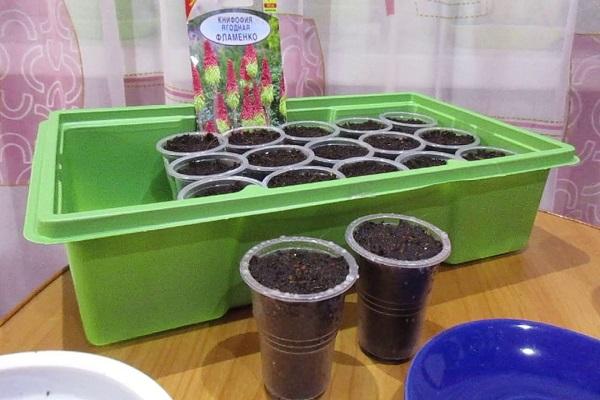
Seedling
The method of growing seedlings is more reliable. They do this indoors or in a special greenhouse. After the sprouts get stronger, they are planted in open ground. To do this, make holes up to 4 centimeters deep, keeping a distance of 20-25 centimeters. The soil must be thoroughly loosened and moistened. Normally, seedlings appear one and a half months after planting.
What time is better to plant
Seedlings are planted in the ground at the end of March. At the same time, a place is chosen depending on the type of heuchera:
- Varieties with bright red foliage thrive in bright sunshine and become even more attractive. They can be planted on the south side, subject to regular watering.
- For varieties with foliage of delicate colors, the east or west side is suitable, where there is shadow or diffused lighting.

Permanent site preparation
In order for the decorative qualities of the plant to fully develop, it is recommended to plant it in fertile, loose soil. It is important that a neutral or slightly alkaline pH balance (5-6 units) is observed. In acidic soil, the plant begins to ache and dies. The soil should be moisture-absorbing, but moisture stagnation at the roots should also not be allowed. When preparing the holes, a drainage layer of 3-5 mm should be created.
Outdoor transplant
Having placed the seedlings in open ground, you need to regularly loosen and moisten it. Adequate air and moisture at the roots is essential for healthy growth. But you cannot plant a plant in a swampy area. Contact with water will lead to root rot, disease and loss of decorative qualities.
Care Tips
Heuchera is an unpretentious plant. When planted in good quality soil, in an area with sufficient sunlight, it requires minimal maintenance.

Watering crops
The shrub should be watered regularly. Checking the condition of the soil, they conclude that it needs to be moistened again. In the hot period, the bushes are watered every other day, thoroughly moistening the soil in the planting area. It is impossible to flood the plant too much in order to prevent root decay.
Plant feeding
The plant does not require frequent feeding, since in its natural environment it grows on poor soil in mountainous areas. Top dressing should start a year after planting in the ground.Depending on the variety of heuchera, mineral fertilizer is used for deciduous or flowering plants.
Top dressing is applied twice a season - before and after the flowering period, in moderation. The solution is made less concentrated than recommended by the manufacturer.
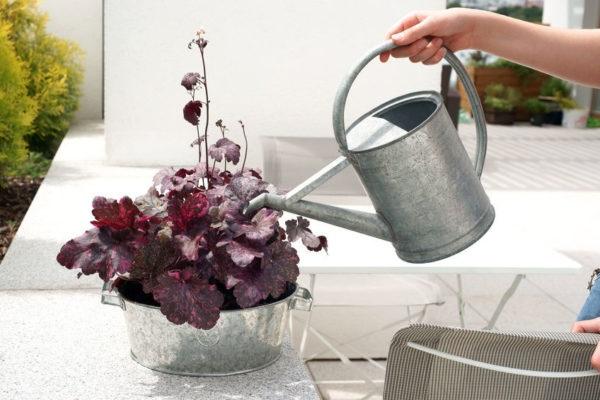
Pruning rules
Geuchera is an evergreen crop, therefore it does not need pruning before winter. Old, wilted leaves keep the roots warm during the winter frosts. They are removed after wintering, cutting them closer to the soil surface. Peat with humus is added under the bushes (mulch).
How to prepare a plant for winter
For the winter, the bushes are covered using spruce branches or rotted oak leaves. In order to remove the protective cover, they are waiting for the final thawing and warming of the earth.
Protection against diseases and pests
Heuchera is not susceptible to disease. The condition of the plant deteriorates in the presence of provoking factors - prolonged contact of roots with water or excessive soil mineralization. The most common diseases are:
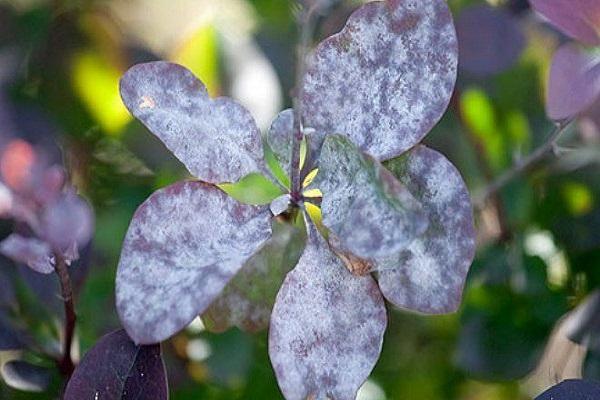
- powdery mildew;
- gray rot;
- spotting;
- rust.
The plant is treated with fungicidal preparations: Bordeaux mixture (solution of copper sulfate in lime milk), Fundazol, Fitosporin - M. Of the pests, grape snails, caterpillars, slugs, leaf parasites are dangerous. For protection, insecticide treatment is used.
It is very useful to make regular hilling of bushes. Then the upper bare part of the roots will be reliably covered from the effects of the external environment.
Breeding methods
At the age of 3-4 years, heuchera bushes need rejuvenation. If this is not done, their ability to resist parasites and diseases will deteriorate, and winter hardiness will decrease..
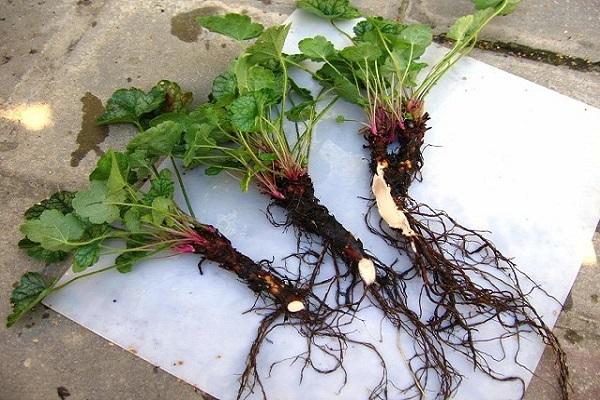
Rejuvenation is done by dividing and replanting bushes. The procedure is carried out in late spring or early autumn. Divide the bush into parts, providing each with 2-3 outlets. Along the way, they clean the roots of rotten areas. The resulting children are seated in the holes located at a distance of 30 centimeters. Plants are abundantly watered and mulched. Rooting of young Heucheras takes place within a month.
Reproduction by grafting is also used. Cuttings are cut from the parent plant and rooted in greenhouses, planted in a peat-sand mixture. They are waiting for the formation of the roots of a new plant.
Problems for growers when growing
In order for the planting and caring of the garden geyhera to be successful, the rules should be carefully followed. Otherwise, the flower will start to ache and may die.
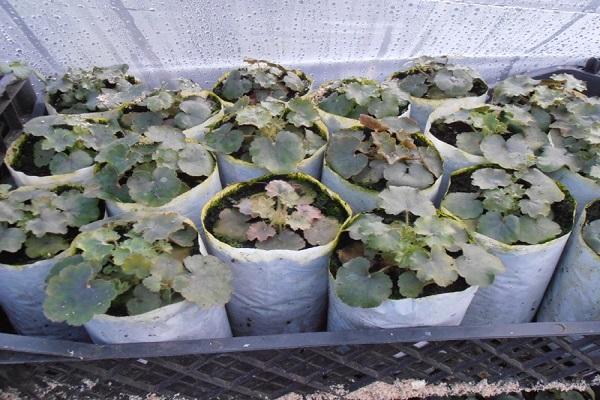
- Having bought seedlings, it is recommended to plant them in the ground as soon as possible. In the dry air of a city apartment, the sprouts will quickly die.
- It is necessary to clearly adjust the optimal amount of liquid when watering. A deficiency will lead to wilting of the leaves, flooding will end with the death of the roots.
- The lack of a drainage layer in the holes can lead to stagnation of liquid and rotting of the roots.
- To preserve the decorative properties, it is important that the plants are planted in fertile soil.
Compliance with the rules of care and planting are necessary conditions for the heuchera bushes to grow healthy and picturesque. Well-groomed plants will delight their owners with bright, elegant foliage for many years.
